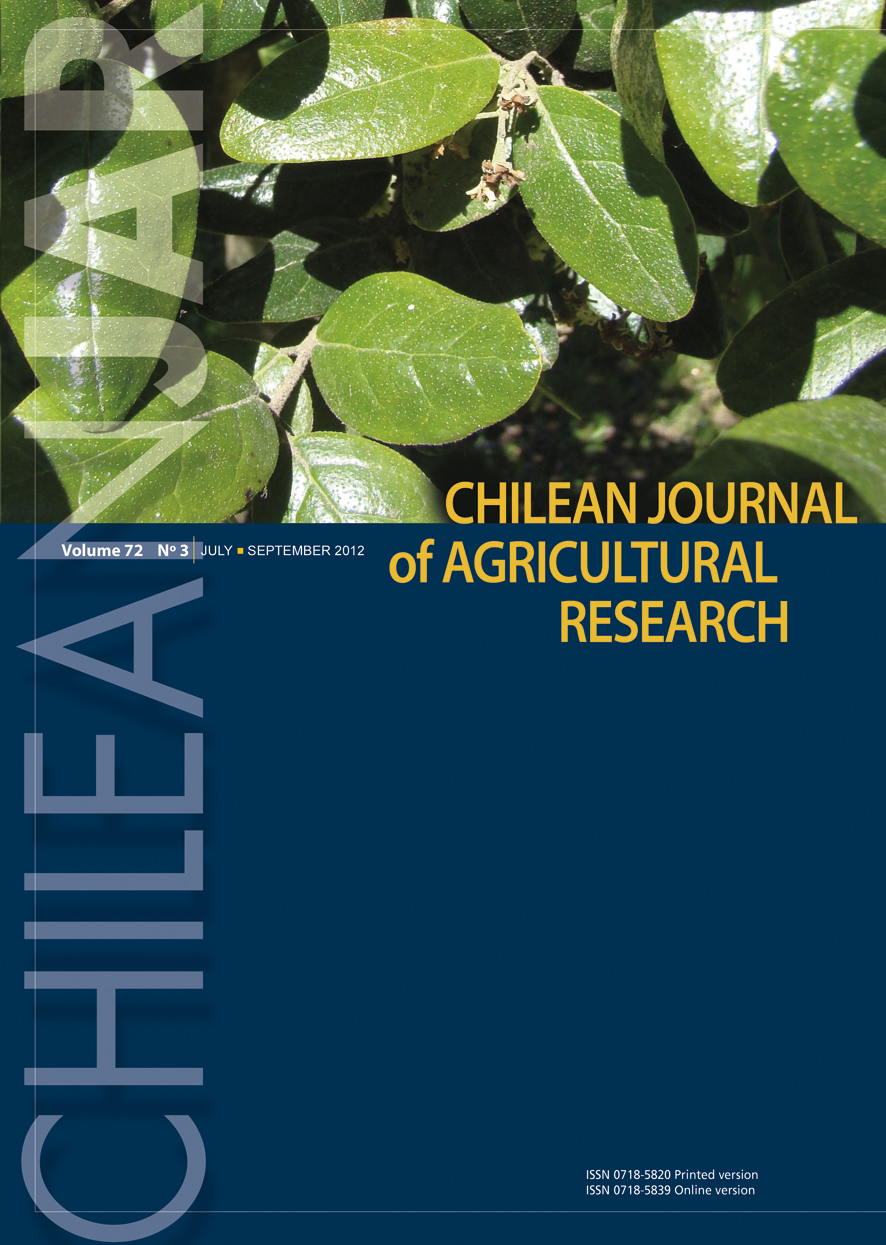
|
Chilean Journal of Agricultural Research
Instituto de Investigaciones Agropecuarias, INIA
ISSN: 0718-5820
EISSN: 0718-5820
Vol. 71, No. 1, 2011, pp. 140-147
|
 Bioline Code: cj11017
Bioline Code: cj11017
Full paper language: English
Document type: Research Article
Document available free of charge
|
|
|
Chilean Journal of Agricultural Research, Vol. 71, No. 1, 2011, pp. 140-147
| es |
Caracterización del Banco de Semillas de Malezas en Labranza Cero y Convencional en Chile Central.
Caroca, Rosa Peralta; Candia, Paola Silva & Hinojosa, Edmundo Acevedo
Resumen
Se estudió la abundancia, composición de especies y distribución en profundidad del banco de semilla de maleza en labranza convencional (CT) y cero labranza (NT) en dos sitios, A y B. Se tomaron muestras a tres profundidades de suelo (0-2, 2-5 y 5-15 cm). Se contaron semillas germinadas, dormantes y totales. La cantidad total de semillas fue significativamente mayor (p ≤ 0,05) para ambos sitios (CTA = 5175 semillas m-2, NTA = 3250 semillas m-2, CTB = 33770 semillas m-2 y NTB = 22437 semillas m-2). La cantidad de semillas viables, dormantes y germinadas fue significativamente mayor (p ≤ 0.05) para ambos ensayos en CT que en NT. La mayor proporción de las semillas viables correspondió a germinadas. Se observó un bajo porcentaje de semillas viables 37% (CTA), 34% (CTB), 21% (NTA) and 8% (NTB). Las semillas viables de Chenopodium album L. (CHEAL) dominaron en ambos ensayos 67% (CTA), 20% (NTA), 96% (CTB) y 77% (NTB). En el análisis de componentes principales, el CP 1 separó las especies de malezas de semillas viables por sistema de labranza y el CP 2 separó por sitios. Poa annua L. fue la especie más importante asociada a NT seguida por Cichorium intybus L. y Sonchus, mientras que Euphorbia helioscopia L. y Echinochloa crus-galli (L.) P. Beauv. estuvieron asociadas a CT.
Palabras-clave
siembra directa, composición de especies, abundancia, distribución en profundidad
|
| |
| en |
Characterization of the Weed Seed Bank in Zero and Conventional Tillage in Central Chile
Caroca, Rosa Peralta; Candia, Paola Silva & Hinojosa, Edmundo Acevedo
Abstract
We studied the abundance, species composition, and depth distribution of the weed seed bank under no-tillage (NT) and conventional tillage (CT) at two sites, A and B. Soil samples were taken at three soil depths (0-2, 2-5, and 5-15 cm). Germinated, dormant, and total seeds were counted. The total number of seeds was higher (p ≤ 0.05) under CT treatment at the two sites (CTA = 5175 seeds m-2, NTA = 3250 seeds m-2, CTB = 33770 m-2, and NTB = 22437 seeds m-2). The number of viable, dormant, and germinated seeds was also higher (p ≤ 0.05) in CT at the two sites. The percentage of viable seeds was low with 37% (CTA), 34% (CTB), 21% (NTA), and 8% (NTB). Viable seeds of Chenopodium album L. (CHEAL) dominated in the two trials with 67% (CTA), 20% (NTA), 96% (CTB), and 77% (NTB). In a principal component analysis, PC1 separated viable seeds of weed species according to tillage and PC2 separated weed species according to sites. Poa annua L. was the most important species associated with NT followed by Cichorium intybus L., and Sonchus while Euphorbia helioscopia L. and Echinochloa crus-galli (L.) P. Beauv. were associated with CT.
Keywords
no-tillage, species composition, abundance, depth distribution.
|
| |
© Copyright 2010 Chilean Journal of Agricultural Research.
Alternative site location: http://www.inia.cl
|
|
